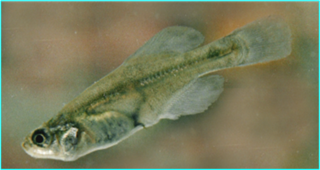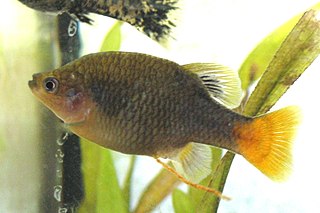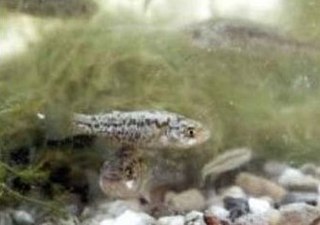
Cyprinodontiformes is an order of ray-finned fish, comprising mostly small, freshwater fish. Many popular aquarium fish, such as killifish and live-bearers, are included. They are closely related to the Atheriniformes and are occasionally included with them. A colloquial term for the order as a whole is toothcarps, though they are not actually close relatives of the true carps – the latter belong to the superorder Ostariophysi, while the toothcarps are Acanthopterygii.

The butterfly splitfin or butterfly goodeid is a bony fish from the monotypic genus Ameca of the splitfin family (Goodeidae). It was formerly found throughout the Ameca River drainage in Mexico; the type locality is Rio Teuchitlán in the vicinity of Teuchitlán, Jalisco. The species was only ever found in an area about 10 miles (15 km) in diameter.

The White River springfish is a species of fish in the family Goodeidae, the splitfins. It is a rare species of the Great Basin of western United States, where it is endemic to isolated warm springs in the White River drainage of eastern Nevada.

The rainbow goodeid is a species of critically endangered freshwater fish in the family Goodeidae, and are endemic to Mexico. Specifically, they are found in shallow springs and ponds in the Durango and Coahuila area. They were first identified in 1866 by Albert Günther.
The blackspot allotoca, also known as the blackspot goodeid, tailspot goodeid, or tiro manchado, is a critically endangered species of fish in the family Goodeidae, endemic to the Lago de Magdalena basin near Guadalajara in Jalisco, Mexico.
Allotoca is a genus of splitfins that are endemic to west-central and southwest Mexico, where restricted to the Lerna–Chapala–Grande de Santiago, Ameca and Balsas river basins, as well as various endorheic lake basins in Michoacán and Jalisco. All Allotoca species are seriously threatened.
The striped goodeid, bluetail goodeid or bluetail goodea is an endangered species of fish in the family Goodeidae. Its genus Ataeniobius is monotypic. It is endemic to the Río Verde and associated waters, including the Media Luna and Los Anteojitos lakes, in San Luis Potosí, Mexico. The specific name of this fish honours its discoverer, the America evolutionary biologist William Lawrence Tower (1872–1955) of the University of Chicago.
The dark-edged splitfin is a species of fish in the family Goodeidae endemic to Mexico. It is a live-bearing, cold-water fish from the mountains of Mexico. The species is incredibly temperature sensitive. If water is too cold, all offspring turn out to be male. If water is too hot, females will birth their first brood of only 1–3 fry and then die shortly thereafter, which makes it very difficult to maintain a colony. It is also a primarily carnivorous species that eats a variety of insects. Girardinichtys multiradiatus is an endangered species with multiple population threats with little conservation efforts put in place to protect the species.

Girardinichthys is a genus of splitfins that are endemic to Mexico. These highly threatened fish are native to the upper Lerma and Balsas basins, as well as water systems in the Valley of Mexico. Through man-made channels G. viviparus has been able to spread to the upper Pánuco River basin. These small fish reach up to 6.5 cm (2.6 in) in length. The name of this genus honours the American herpetologist and ichthyologist Charles Girard (1822-1895).

The Highland splitfin is a species of splitfin endemic to Mexico where it is found in the Lerma River basin. This species grows to a length of 5 centimetres (2.0 in) TL. It is the only known member of its genus, although some authorities have Hubbina as a subgenus of Girardinichthys and add Girardinichthys ireneae to the subgenus, even treating this taxon as a synonym of G. ireneae. This species was described by Don Fernando de Buen y Lozano in 1940 with the type locality given as Cointzio, Michoacán. The name of the genus honours the American ichthyologist Carl Leavitt Hubbs (1894-1979) while the specific name honours Clarence Lester Turner (1890-1969), thus honouring two ichthyologists who worked on a review of the Goodeidae in 1939.

The Ameca River is a river of some 230 km (140 mi) in length in western Mexico. It originates in the Bosque de la Primavera in Jalisco, 23 km to the west of state capital Guadalajara; flows through the city of Ameca; and then forms the boundary between Jalisco and Nayarit on its way to the Pacific Ocean, where it drains into the Bahía de Banderas at Puerto Vallarta, Jalisco. Its main tributaries are the Ahuacatlán and Amatlán de Cañas.

Xenotoca is a genus of fish in the family Goodeidae from Mexico, where various species are found in a wide range of habitats, from rivers and creeks to pools and lakes, in the Lerma–Grande de Santiago, Panuco, Cuitzeo and other basins of the Mesa Central. While no goodeid is a very common aquarium fish, the redtail splitfin, is one of the most common aquarium goodeids; its bright colors offset its reputation for being aggressive towards and occasionally even killing tankmates. Similarly to X. eiseni, two species described in 2016 have males with red-orange tails, but this feature is not shared by the remaining members of the genus. All Xenotoca species are relatively small, reaching up to 9 cm (4 in) in standard length.

The redtail splitfin or redtail goodeid is a species of goodeid fish from the family Goodeidae and subfamily Goodeinae. Like other members of Goodeinae, the redtail splitfin is native to Mexico and a livebearer. However, the goodeid mating system differs in several ways from the more common livebearing fish from the family Poeciliidae that includes guppies and swordtails. While no goodeid species is a very popular aquarium fish, the redtail splitfin is one of the most popular. Only the male has the red-orange tail for which it is named. Its specific name honours the collector of the type, Gustav Eisen (1847–1940) who was Curator of Marine Invertebrates at the California Academy of Sciences in San Francisco, California.

Goodeinae is a subfamily of splitfins from Mexico, part of the family Goodeidae. They are small fish which mostly live in fresh water, especially around Mesa Central, west of Mexico City. Members of the subfamily are also found in brackish water on both the east and west coasts. They typically have small ranges and many are seriously threatened. The subfamily takes its name from its type genus Goodea and so is ultimately named after the American ichthyologist George Brown Goode (1851-1896).

Zoogoneticus tequila, Tequila splitfin or simply Tequila fish, is a species of goodeid fish from Mexico. The specific epithet, tequila, derives from the Tequila Volcano, which looms near the type locality.

Empetrichthys is a genus of splitfins endemic to the state of Nevada in the United States. In 1989 they only had an estimated population of 24800, while its two other subspecies had gone extinct. This species mating season typically falls in spring. These animals are in danger and facing threats because their water is drying out because of pumping of ground water for agricultural developments.
Skiffia francesae, the golden skiffia or tiro dorado, is a species of splitfin endemic to the Rio Teuchitlán, a tributary of Río Ameca in western Mexico. It is extinct in the wild, but has been maintained in aquaria and the aquarium hobbyist trade.

Empetrichthyinae is a subfamily of fishes, one of two subfamilies that make up the family Goodeidae.

Allotoca goslinei, commonly known as the banded allotoca or tiro rayado in Spanish, is a species of fish in the family Goodeidae. First described in 1987, it was once endemic only to the Ameca River basin in the Mexican state of Jalisco. It is now known to be extinct in the wild.

Xenotoca doadrioi or San Marcos redtail splitfin is a bony fish species in the goodeid family. Until 2016 it was considered to be a variant of the redtail goodeid, X. eiseni, sometimes referred to as the San Marcos variant. A 2016 study by Omar Dominguez-Dominguez, et al. split the redtail goodeid into three separate species: X. eiseni, X. doadrioi and X. lyonsi.












